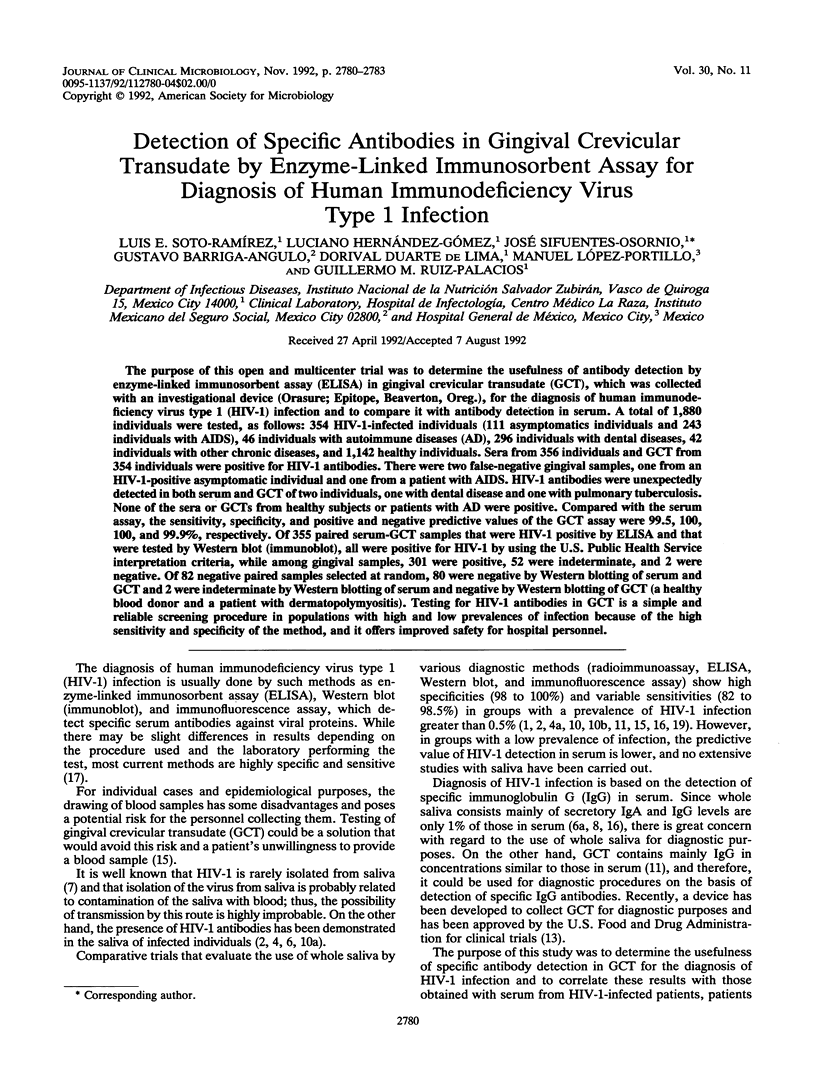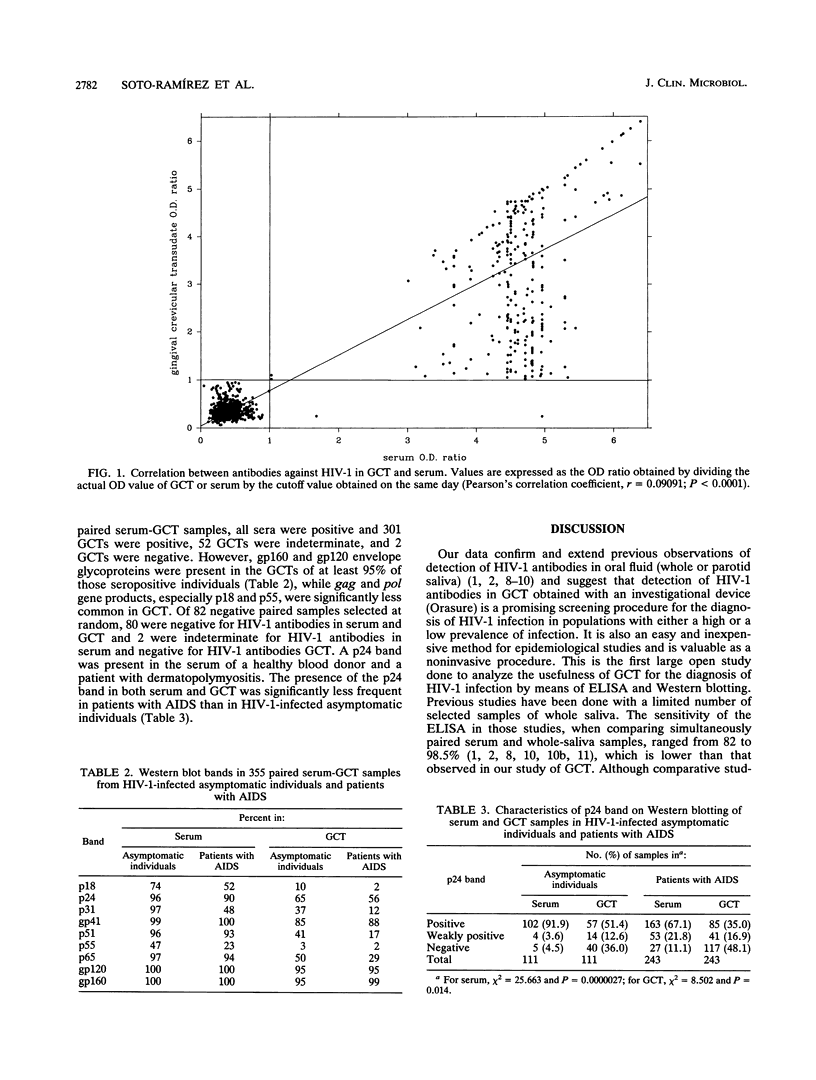Abstract
The purpose of this open and multicenter trial was to determine the usefulness of antibody detection by enzyme-linked immunosorbent assay (ELISA) in gingival crevicular transudate (GCT), which was collected with an investigational device (Orasure; Epitope, Beaverton, Oreg.), for the diagnosis of human immunodeficiency virus type 1 (HIV-1) infection and to compare it with antibody detection in serum. A total of 1,880 individuals were tested, as follows: 354 HIV-1-infected individuals (111 asymptomatics individuals and 243 individuals with AIDS), 46 individuals with autoimmune diseases (AD), 296 individuals with dental diseases, 42 individuals with other chronic diseases, and 1,142 healthy individuals. Sera from 356 individuals and GCT from 354 individuals were positive for HIV-1 antibodies. There were two false-negative gingival samples, one from an HIV-1-positive asymptomatic individual and one from a patient with AIDS. HIV-1 antibodies were unexpectedly detected in both serum and GCT of two individuals, one with dental disease and one with pulmonary tuberculosis. None of the sera or GCTs from healthy subjects or patients with AD were positive. Compared with the serum assay, the sensitivity, specificity, and positive and negative predictive values of the GCT assay were 99.5, 100, 100, and 99.9%, respectively. Of 355 paired serum-GCT samples that were HIV-1 positive by ELISA and that were tested by Western blot (immunoblot), all were positive for HIV-1 by using the U.S. Public Health Service interpretation criteria, while among gingival samples, 301 were positive, 52 were indeterminate, and 2 were negative. Of 82 negative paired samples selected at random, 80 were negative by Western blotting of serum and GCT and 2 were indeterminate by Western blotting of serum and negative by Western blotting of GCT (a healthy blood donor and a patient with dermatopolymyositis). Testing for HIV-1 antibodies in GCT is a simple and reliable screening procedure in populations with high and low prevalences of infection because of the high sensitivity and specificity of the method, and it offers improved safety for hospital personnel.
Full text
PDF



Selected References
These references are in PubMed. This may not be the complete list of references from this article.
- Archibald D. W., Johnson J. P., Nair P., Alger L. S., Hebert C. A., Davis E., Hines S. E. Detection of salivary immunoglobulin A antibodies to HIV-1 in infants and children. AIDS. 1990 May;4(5):417–420. doi: 10.1097/00002030-199005000-00006. [DOI] [PubMed] [Google Scholar]
- Archibald D. W., Zon L. I., Groopman J. E., Allan J. S., McLane M. F., Essex M. E. Salivary antibodies as a means of detecting human T cell lymphotropic virus type III/lymphadenopathy-associated virus infection. J Clin Microbiol. 1986 Nov;24(5):873–875. doi: 10.1128/jcm.24.5.873-875.1986. [DOI] [PMC free article] [PubMed] [Google Scholar]
- Atkinson J. C., Yeh C., Oppenheim F. G., Bermudez D., Baum B. J., Fox P. C. Elevation of salivary antimicrobial proteins following HIV-1 infection. J Acquir Immune Defic Syndr. 1990;3(1):41–48. [PubMed] [Google Scholar]
- Fox P. C., Wolff A., Yeh C. K., Atkinson J. C., Baum B. J. Salivary inhibition of HIV-1 infectivity: functional properties and distribution in men, women, and children. J Am Dent Assoc. 1989 Jun;118(6):709–711. doi: 10.14219/jada.archive.1989.0165. [DOI] [PubMed] [Google Scholar]
- Ho D. D., Byington R. E., Schooley R. T., Flynn T., Rota T. R., Hirsch M. S. Infrequency of isolation of HTLV-III virus from saliva in AIDS. N Engl J Med. 1985 Dec 19;313(25):1606–1606. doi: 10.1056/NEJM198512193132512. [DOI] [PubMed] [Google Scholar]
- Holmström P., Syrjänen S., Laine P., Valle S. L., Suni J. HIV antibodies in whole saliva detected by ELISA and western blot assays. J Med Virol. 1990 Apr;30(4):245–248. doi: 10.1002/jmv.1890300403. [DOI] [PubMed] [Google Scholar]
- Johnson A. M., Parry J. V., Best S. J., Smith A. M., de Silva M., Mortimer P. P. HIV surveillance by testing saliva. AIDS. 1988 Oct;2(5):369–371. doi: 10.1097/00002030-198810000-00006. [DOI] [PubMed] [Google Scholar]
- Major C. J., Read S. E., Coates R. A., Francis A., McLaughlin B. J., Millson M., Shepherd F., Fanning M., Calzavara L., MacFadden D. Comparison of saliva and blood for human immunodeficiency virus prevalence testing. J Infect Dis. 1991 Apr;163(4):699–702. doi: 10.1093/infdis/163.4.699. [DOI] [PubMed] [Google Scholar]
- Parry J. V., Perry K. R., Mortimer P. P. Sensitive assays for viral antibodies in saliva: an alternative to tests on serum. Lancet. 1987 Jul 11;2(8550):72–75. doi: 10.1016/s0140-6736(87)92737-1. [DOI] [PubMed] [Google Scholar]
- Schaefer E. AIDS testing. Trial approved for saliva test. Nature. 1990 Aug 23;346(6286):687–687. doi: 10.1038/346687b0. [DOI] [PubMed] [Google Scholar]
- Schmidt G., Amiraian K., Frey H., Stevens R. W., Berns D. S. Densitometric analysis of Western blot (immunoblot) assays for human immunodeficiency virus antibodies and correlation with clinical status. J Clin Microbiol. 1987 Oct;25(10):1993–1998. doi: 10.1128/jcm.25.10.1993-1998.1987. [DOI] [PMC free article] [PubMed] [Google Scholar]
- Shoeman R. L., Pottathil R., Metroka C. Antibodies to HIV in saliva. N Engl J Med. 1989 Apr 27;320(17):1145–1146. doi: 10.1056/NEJM198904273201712. [DOI] [PubMed] [Google Scholar]
- Sun D., Archibald D. W., Furth P. A. Variation of secretory antibodies in parotid saliva to human immunodeficiency virus type 1 with HIV-1 disease stage. AIDS Res Hum Retroviruses. 1990 Jul;6(7):933–941. doi: 10.1089/aid.1990.6.933. [DOI] [PubMed] [Google Scholar]


